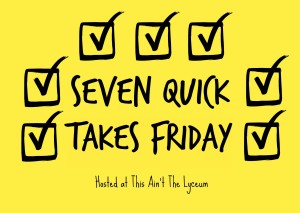I’m really pleased to announce to all of you, that tomorrow, I begin my new weekly radio show with Real Life Radio. My program is an hour long, and is called “Fights In Good Faith” And the header image makes excellent use of one of the shots Sydney Angel took when I did the headshots for my book:
The show will stream on Saturdays at 5pm and repeat on Sunday at 1pm (plus the shows will be archived). And, for the very first episode, I’ve made sure to front-load the most important topics I could cover.
Thus, it’s going to be half on useful dispositions to have in an argument and…. half on Into the Woods.
I’m just starting out, so I’d appreciate suggestions for things you’d like to see on future shows. I’m especially amenable to trying to deliver cunningly coded message, after reading this article on a (successful!) Colombian program to write pop songs with hidden Morse code messages, to communicate with FARC’s hostages.
Ortiz had designed unorthodox campaigns to battle the FARC before. In 2008, he dreamed up an operation to persuade pregnant female guerrillas to defect: the army air-dropped 7 million pacifiers into the jungle with a message encouraging rebels to return to civilization. The operation involved seven helicopters, three airplanes, 960 flight hours, 17,800 gallons of fuel, and 72 soldiers flying twice a week for four months. During the holidays, the army illuminated giant Christmas trees across the jungle to remind guerrillas what they were missing. They also wrote messages promoting peace on soccer balls and floated them down the river toward the rebel encampments.
If we stick to the topic of audacious plots, touched by absurdity, then I have every excuse to share with you the story I recently found on how the Booth brothers (yes, that Booth) accidentally helped defuse a Confederate plot.
Confederate saboteurs had infiltrated New York City via Canada, intending originally to disrupt the Nov. 8 presidential election. Thwarted by an infusion of federal troops, but still incensed by the Union Army’s scorched earth campaign against Southern military installations and industrial sites, they tried to set the city ablaze instead.
The Booth boys were on stage at the time, and you can click through to the article to see how they wound up minimizing the panic and destruction the arson was intended to cause.
And if I used the Morse code song to segue into other stories of elaborately designed communications, I can go on to recommend Hall of Femmes’s interview with Gun Larson, the calligrapher who has written (among many other things) all the titles on the Library of America series.
Gun’s writing is one of the made things I pass over without thinking about how it came to be. But, this week, I was one of the lucky 10,000.
Also on the list of pursuits-whose-logistics-I-had-not-paused-to-consider: camel racing. If I had tried to think about how these worked, I might have guessed the camels just ran on their own, or that they were ridden by jockeys, like horses. I would not have come up with this:
Some owners said quietly that they still might prefer to have human jockeys — though none would say so publicly — but a majority, perhaps recognizing the troubling perception of having children ride animals that stand 6 feet tall and can run up to 40 miles per hour, unabashedly praised the technology now widely used instead: robots.
Early models of the robots, which were first produced in 2003, were cumbersome and weighed as much as 30 pounds. The camels generally did not respond well to them, and owners were put off by the difficulty of obtaining them.
Not only are the camels ridden by robots, but, in order to control them, the owners are all in SUVs, riding around an outer track to keep an eye on their camel.
From the annals of the more intentionally humorous, Ibi, Spain has an annual coup.
The coup in Ibi is staged on the Day of the Holy Innocents, Spain’s equivalent of April Fools’ Day. It is a blend of carnival and anarchy, albeit carefully orchestrated.
The night before the coup, the 20 or so conspirators, known as Els Enfarinats (The Flour Men), drove around the town in a truck, reciting diatribes mostly targeting politicians and local businessmen.
At dawn on Dec. 28, they assembled in their headquarters, put on their makeup and uniforms and gathered their ammunition — flour bags, egg boxes, fire extinguishers and firecrackers. Around 9 a.m., they assaulted the town hall and ousted the mayor.
A mock “opposition” group of residents rapidly formed, and challenged the rebels on Ibi’s church square. After their battle, both groups agreed to a cease-fire, during which they visited the bars and shops around Ibi, introducing random laws while jailing or imposing fines on those who disobeyed them.
The mock fines, which are noted in a ledger in purposefully illegible writing, are used as charitable donations, earmarked for a local home for older adults.
And, finally, a really interesting piece from The New Yorker by a writer with Bell’s Palsy, who wouldn’t be able to smile at any of these links, or at anything else.
Sometimes more elaborate stratagems are required. One of them is the “pick play.” In sports, a pick is a blocking move in which the player with the ball uses a stationary teammate as an obstruction, freeing up the player to pass or shoot. In my variation, my wife or an agreeable friend stays on my left as I move about or stand in a group. The idea came to me one evening at a dinner party. Old friends happened to be seated on my left, and people I’d just met were on my right. Toward the end of the meal, I noticed that I hadn’t needed to resort to my stutterer strategy. No quizzical looks had come my way. The new acquaintances had seen only my good side, while my understanding friends on the left had fielded most of my distortions.
I first tried out my strategy at a cast party for a new production that had opened Off Broadway. I was eager to talk to one particular actor. I waited for an opening, introduced myself, smiled—and absorbed his perplexed reaction. I said I’d be back in a moment, and returned with my wife, whom I planted on my left so that the actor, on my right, faced her directly and me in profile. “We saw your Hamlet—did Jonathan tell you?” Julie said. “We went to a matinée and then talked about it the entire night afterward.” I saw the actor glance at me as I looked at my wife; I could now plausibly continue the three-way conversation without turning to face him directly. Within minutes, I was asking him questions about his working relationship with the actress playing Gertrude, who was known to be intimidating, and he looked me in the eyes and tracked my emotions. He seemed not to notice that I’d shown him only my profile before, and from then on it didn’t matter.
Some of his coping mechanisms reminded me of my college strategy for dealing with my faceblindness — I taught my then-boyfriend the ASL alphabet, and he would slip behind the people I was talking to and spell their names to me behind their heads. Post-college, I’ve just made people wear nametags at my parties and debates (ostensibly for the benefit of anyone who is new).
For more Quick Takes, visit Conversion Diary!



















